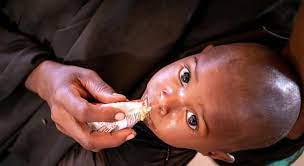
Catastrophic hunger levels in Somalia have left more than 513,000 children at risk of dying, 173,000 more than during the 2011 famine, UN humanitarians warned on Tuesday.
In a call for immediate funding to help vulnerable communities hit by successive droughts, high food prices and conflict, the UN Children’s Fund UNICEF, the World Food Programme (WFP) and Food and Agriculture Organization (FAO) stressed that the emergency shows no signs of letting up.
Without action, famine “will occur within the next few weeks”, FAO said.
The UN agency added that drought-related deaths “have been occurring” and the toll could be much higher in hard-to-reach rural areas, compared with the number recorded in camps for displaced families.
A ‘nightmare’ not seen this century
During the famine of 2011, 340,000 children required treatment for severe acute malnutrition, UNICEF spokesperson James Elder told journalists in Geneva. “Today it’s 513,000,” he added. “It’s a pending nightmare we have not seen this century.”
According to FAO, approximately 6.7 million people across Somalia will likely endure high levels of acute food insecurity between October and December this year (IPC Phase 3 or above).
This includes more than 300,000 who have been left “empty-handed” by the country’s triple emergency and who are expected to fall into famine (IPC Phase 5).
Livestock dropping dead
In pastoral communities where herders have been desperately searching for pasture, “they are now watching their livestock drop dead like flies”, said Etienne Peterschmitt, FAO Representative in Somalia.
The perilous situation of those forced from their homes by hunger in Baidoa town of Bay region in Southern Somalia, is particularly concerning, Mr. Peterschmitt added.
“The repeated warnings have been clear: act now or a famine will occur within the next few weeks,” he insisted.
“The drought situation is spreading at an alarming rate; more districts and regions are facing emergency levels of food insecurity as the cumulative effects of multiple failed rainy seasons take their toll.”
In a call for radical change to stop famine happening again, UNICEF’s Mr. Elder described the disturbing scenes already playing out in Somalia’s worst-affected region.
Everyday bugs now deadly
“Children are already dying,” he said. “Our partners report that some stabilization centres are in fact full and critically-ill children are receiving treatment on the floor.”
With greater funding, more severe and acutely malnourished children can be given lifesaving food which will make them strong enough to ward off diseases, just like healthier youngsters.
“This is not just about nutrition, severely malnourished children are in fact up to 11 times more likely to die from things like diarrhoea and measles than well-nourished boys and girls,” Mr. Elder said, adding that both diseases “are spiking” in the worst-hit areas.
The UN’s response involves reaching the most vulnerable communities to prevent mass displacement before famine has been declared, to help to promote a faster recovery.
Humanitarian assistance has been increasing and reached an average of 3.1 million people per month between April and June 2022 and 4.5 million people per month between July and September 2022, according to FAO’s Mr. Peterschmitt.
“We know that the deaths, half of the deaths of 2011, happened before the declaration of famine,” said El-Khidir Daloum, WFP Somalia Representative and Country Director.
“As we speak right now, we are heading to 15 areas classified as hard-to-reach and we are scaling up together with UNICEF, the nutrition and the priority areas.”
In June, UNICEF reported that 386,000 children aged six to 59 months needed treatment for severe acute malnutrition. “That’s increased (today) to more than half a million, to 513,000; that’s a 33 per cent increase. Said one more way, it means 127,000 more children are at risk of death,” Mr. Elder said.
Source: UN News
https://news.un.org/en/story/2022/09/1126491
 FR
FR EN
EN AR
AR








